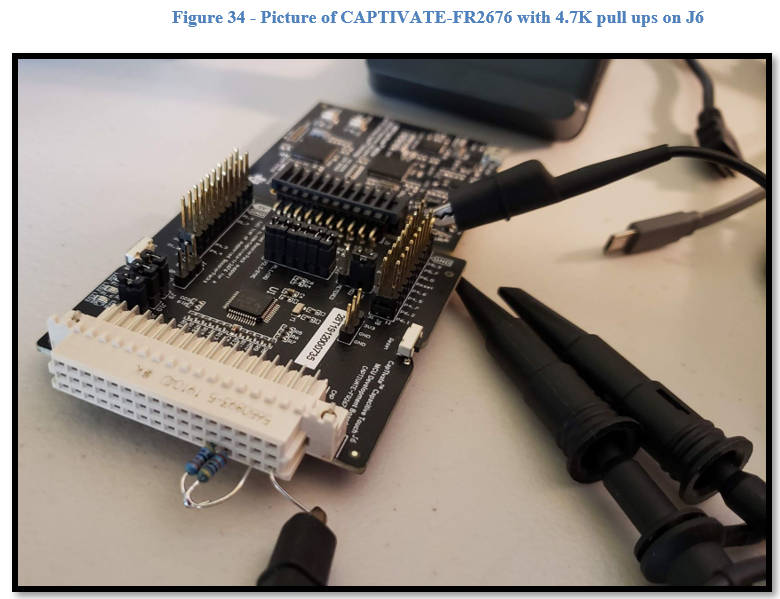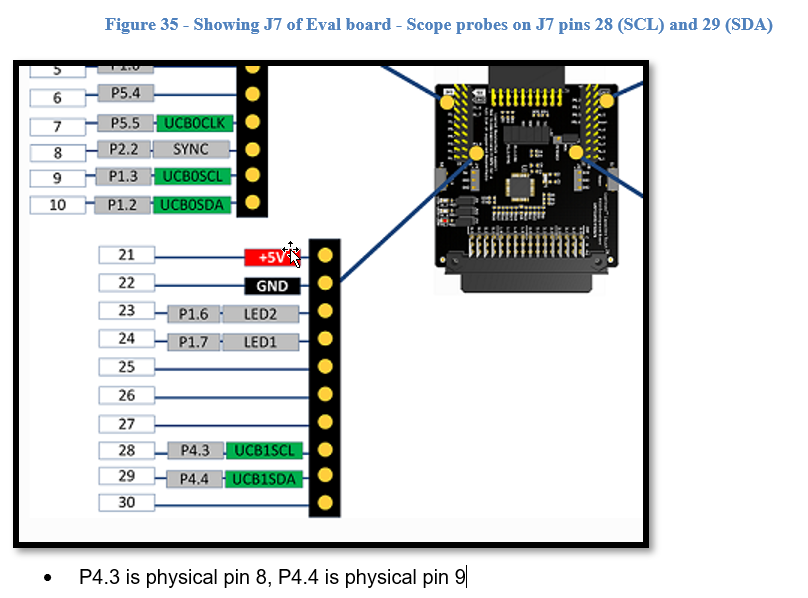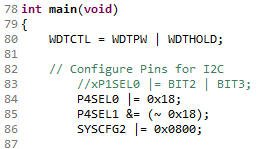Other Parts Discussed in Thread: CAPTIVATE-FR2676, CAPTIVATE-PGMR, , MSP430FR2476
Good Morning,
I have to be missing something so simple! I know will feel dumb when someone shows me what I missed - but at this point - I can take it!!
- Any help will be so much appreciated :)
QUESTION:
- What dumb setting am I missing?
SYMPTOM:
- Have scope on P4.3 (SCL) & P4.4 (SDA) of CAPTIVATE-FR2676 Eval board (J7 pins 28 & 29)- and NEVER see any activity (yes my scope is set up correctly LOL)
INFO:
- I am using CCS, with the CAPTIVATE-PGMR & CAPTIVATE-FR2676 Eval board (MSP430FR2676TPTmicro - 48 LQFP package).
- No Slave is attached but configuring as Master so should still see something
- Have external 4.7K ohm pull ups on SCL and SDA
- I used Example code MSP430FR267x_euscib0_i2C_15 as starting point: (Master Code)
- Again want as master – so can see sending out Slave Address
- The example uses euscib0.
- Changed code to uses euscib1 (so exposed on J7 header of Eval board – can scope)
- Changed PxSEL registers to use P4.3 (CLK) and P4.4 (SDA) so again can scope.
- Those were the only changes made!!
- I did NOT try the Example code right out of box – since believe the Programmer board is using to program the MSP430.
Again – can’t thank you enough – pull what little hair left on my head out!!
Willie
----------------------------
--------------------
Actual Code:
// MSP430FR267x Demo - eUSCI_B0 I2C Master TX bytes to Multiple Slaves
//
// Description: This demo connects two MSP430's via the I2C bus.
// The master transmits to 4 different I2C slave addresses 0x0A,0x0B,0x0C&0x0D.
// Each slave address has a specific related data in the array TXData[].
// At the end of four I2C transactions the slave address rolls over and begins
// again at 0x0A.
// ACLK = REFO = 32768Hz, MCLK = SMCLK = default DCO = ~1MHz
// Use with msp430fr267x_eUSCIB_04.c
//
// /|\ /|\
// MSP430FR2676 10k 10k MSP430FR2676
// slave | | master
// ----------------- | | -----------------
// | P1.2/UCB0SDA|<-|----|->|P1.2/UCB0SDA |
// | | | | |
// | | | | |
// | P1.3/UCB0SCL|<-|------>|P1.3/UCB0SCL |
// | | | P1.0|--> LED
//
// Longyu Fang
// Texas Instruments Inc.
// August 2018
// Built with IAR Embedded Workbench v7.12.1 & Code Composer Studio v8.1.0
//******************************************************************************
#include <msp430.h>
unsigned char TXData[]= {0xA1,0xB1,0xC1,0xD1}; // Pointer to TX data
unsigned char SlaveAddress[]= {0x0A,0x0B,0x0C,0x0D};
unsigned char TXByteCtr;
unsigned char SlaveFlag = 0;
int main(void)
{
WDTCTL = WDTPW | WDTHOLD; // Stop watchdog timer
// Configure Pins for I2C
//xP1SEL0 |= BIT2 | BIT3; // I2C pins
P4SEL0 |= 0x18; // configure I2C pins (device specific)
P4SEL1 &= (~ 0x18); //Using Physical pins 8,9 of MSP430FR2676TPT (48 LQFP package on Captivate MSP430FR2676 Eval board)
// Disable the GPIO power-on default high-impedance mode
// to activate previously configured port settings
PM5CTL0 &= ~LOCKLPM5;
// Configure USCI_B0 for I2C Master Mode
UCB1CTLW0 |= UCSWRST; // put eUSCI_B in reset state
UCB1CTLW0 |= UCMODE_3 | UCMST | UCSYNC; // I2C master mode, SMCLK, UCA10 = 0 by default from reset
UCB1BRW = 0x8; // baudrate = SMCLK / 8
UCB1CTLW0 &=~ UCSWRST; // clear reset register
UCB1IE |= UCTXIE0 | UCNACKIE; // transmit and NACK interrupt enable
SlaveFlag =0;
while(1)
{
__delay_cycles(1000); // Delay between transmissions
UCB1I2CSA = SlaveAddress[SlaveFlag]; // configure slave address
TXByteCtr = 1; // Load TX byte counter
while (UCB1CTLW0 & UCTXSTP); // Ensure stop condition got sent
UCB1CTLW0 |= UCTR | UCTXSTT; // I2C TX, start condition
//(***** Expect to see some I2C clock signals on scope - but DON'T :( )
// __bis_SR_register(LPM0_bits | GIE); // Enter LPM0 w/ interrupts
// Remain in LPM0 until all data
// is TX'd
// Change Slave address
SlaveFlag++;
if (SlaveFlag>3) // Roll over slave address
{
SlaveFlag =0;
}
}
}
#pragma vector = EUSCI_B1_VECTOR
__interrupt void USCI_B1_ISR(void)
{
switch(__even_in_range(UCB1IV,USCI_I2C_UCBIT9IFG))
{
case USCI_NONE: break; // Vector 0: No interrupts break;
case USCI_I2C_UCALIFG: break;
case USCI_I2C_UCNACKIFG:
UCB1CTL1 |= UCTXSTT; //resend start if NACK
break; // Vector 4: NACKIFG break;
case USCI_I2C_UCSTTIFG: break; // Vector 6: STTIFG break;
case USCI_I2C_UCSTPIFG: break; // Vector 8: STPIFG break;
case USCI_I2C_UCRXIFG3: break; // Vector 10: RXIFG3 break;
case USCI_I2C_UCTXIFG3: break; // Vector 14: TXIFG3 break;
case USCI_I2C_UCRXIFG2: break; // Vector 16: RXIFG2 break;
case USCI_I2C_UCTXIFG2: break; // Vector 18: TXIFG2 break;
case USCI_I2C_UCRXIFG1: break; // Vector 20: RXIFG1 break;
case USCI_I2C_UCTXIFG1: break; // Vector 22: TXIFG1 break;
case USCI_I2C_UCRXIFG0: break; // Vector 24: RXIFG0 break;
case USCI_I2C_UCTXIFG0:
if (TXByteCtr) // Check TX byte counter
{
UCB1TXBUF = TXData[SlaveFlag]; // Load TX buffer
TXByteCtr--; // Decrement TX byte counter
}
else
{
UCB1CTLW0 |= UCTXSTP; // I2C stop condition
UCB1IFG &= ~UCTXIFG; // Clear USCI_B0 TX int flag
__bic_SR_register_on_exit(LPM0_bits); // Exit LPM0
}
break; // Vector 26: TXIFG0 break;
case USCI_I2C_UCBCNTIFG: break; // Vector 28: BCNTIFG
case USCI_I2C_UCCLTOIFG: break; // Vector 30: clock low timeout
case USCI_I2C_UCBIT9IFG: break; // Vector 32: 9th bit
default: break;
}
}




